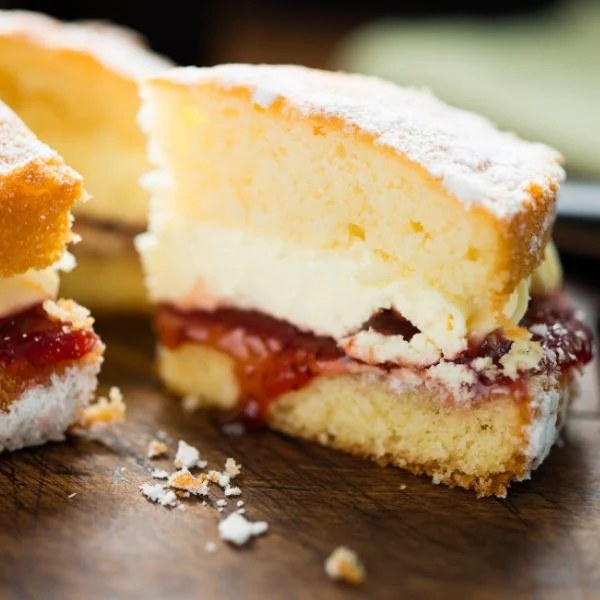Sponge cake is a delicate and light dessert that is loved by many for its fluffy texture and delicious taste. Whether you have leftover sponge cake from a special occasion or you want to make a cake in advance for convenience, you might be wondering if it’s possible to freeze sponge cake without compromising its quality.

Understanding Sponge Cake
Before we delve into the freezing process, let’s take a moment to understand what makes a sponge cake unique. Sponge cake is a type of foam cake that gets its light and fluffy texture from beaten eggs.
Unlike traditional butter cakes, which rely on fat and leavening agents, sponge cake relies on the air incorporated into the eggs to rise and create its characteristic structure.
Freezing Sponge Cake: Is It Possible?
Yes, you can freeze sponge cake. However, it’s important to note that freezing may alter the texture and moisture level of the cake to some extent.
The freezing process can cause slight changes in the cake’s structure and can make it denser upon thawing. Nevertheless, if you follow the right steps and take precautions, you can freeze sponge cake without sacrificing too much of its quality.
Factors to Consider Before Freezing Sponge Cake
Before you embark on freezing your sponge cake, there are a few factors to keep in mind:
Cake Ingredients
The ingredients used in your sponge cake can affect its ability to withstand freezing. Cakes made with natural preservatives like lemon zest or orange juice may have a better chance of maintaining their flavor and texture after freezing.
Cake Texture and Moisture Content
Sponge cakes that are slightly denser and have a moist crumb tend to freeze better than extremely light and dry cakes.
The moisture content in the cake plays a crucial role in preventing it from becoming too dry or crumbly after freezing. If your sponge cake is already on the drier side, it may not freeze as well and could lose some of its softness.
Frosting and Decorations
Consider the type of frosting and decorations on your sponge cake before deciding to freeze it. Some frostings, like buttercream or cream cheese frosting, freeze well and maintain their texture.
However, frostings with high water content, such as whipped cream or custard-based fillings, may separate or become watery upon thawing. Additionally, intricate decorations like fondant or delicate sugar work may not hold up well in the freezer.
The Freezing Process for Sponge Cake
Now that you’ve considered the factors involved, let’s explore the step-by-step process of freezing sponge cake:
Preparation
Before freezing your sponge cake, ensure it has cooled completely. If the cake is warm, condensation can form during freezing, leading to a soggy texture. Once cooled, remove any frosting or decorations that may not freeze well.
Wrapping the Cake
To protect your sponge cake during freezing, it’s important to wrap it properly. Start by tightly wrapping the cake with plastic wrap, ensuring there are no air pockets.
Then, wrap it with a layer of aluminum foil to provide an extra barrier against freezer burn. If your cake has multiple layers, wrap each layer individually before wrapping the entire cake.
Freezing the Cake
Place the wrapped sponge cake in the freezer, ensuring it sits flat to maintain its shape. If possible, avoid placing other items on top of the cake to prevent it from getting squished. Ideally, store the cake in the coldest part of the freezer to maintain its quality.
Thawing and Serving Frozen Sponge Cake
When the time comes to enjoy your frozen sponge cake, it’s important to thaw it properly to preserve its texture and taste. Here are some recommended thawing methods:
Thawing Methods
- Overnight in the refrigerator: Transfer the wrapped sponge cake from the freezer to the refrigerator and let it thaw overnight. This slow thawing process helps the cake retain moisture and prevents any drastic temperature changes.
- Room temperature: If you’re short on time, you can thaw individual cake slices at room temperature. Remove the plastic wrap and foil, place the slice on a plate, and let it thaw for approximately 30 minutes to an hour.
Serving Suggestions
Once the sponge cake is fully thawed, you can serve it as is or dress it up with fresh fruits, a dusting of powdered sugar, or a dollop of whipped cream. Sponge cake pairs well with various fillings, such as fruit preserves, chocolate ganache, or lightly sweetened whipped cream.
Tips for Freezing Sponge Cake
To ensure the best results when freezing sponge cake, consider the following tips:
Using Proper Storage Containers
If you have individual cake slices, store them in airtight freezer-safe containers to prevent freezer burn and maintain freshness. For whole cakes, consider using cake carriers specifically designed for freezer storage.
Labeling and Dating the Cake
To keep track of your frozen sponge cake, label the packaging with the date it was frozen. This way, you can easily identify the age of the cake and ensure you consume it within the recommended timeframe.
Freezing Individual Cake Portions
If you anticipate only needing a few slices of sponge cake at a time, consider freezing individual portions. This way, you can thaw and enjoy only what you need without having to defrost the entire cake.
FAQs
While it’s possible to freeze a sponge cake with cream filling, keep in mind that the texture of the cream may change upon thawing. Cream fillings can become slightly watery or separated. It’s recommended to freeze sponge cakes with cream fillings for shorter durations and consume them within a few weeks for the best quality.
When stored properly in the freezer, a sponge cake can be kept for up to 3 months. However, for optimal taste and texture, it’s best to consume the cake within 1-2 months.
Fondant decorations may not freeze well and can become sticky or lose their shape upon thawing. It’s advisable to remove any fondant decorations before freezing the sponge cake and add them back on after the cake has thawed.
For optimal results, it’s generally recommended to freeze a sponge cake before frosting it. This helps maintain the texture and quality of both the cake and the frosting. However, if the cake is already frosted, you can still freeze it, keeping in mind that the texture of the frosting may be slightly affected.
Conclusion
In conclusion, while freezing sponge cake is possible, it’s important to consider the cake’s ingredients, texture, and decorations. Proper preparation, wrapping, and storage techniques are crucial to maintain the cake’s quality during freezing.
Thawing the cake gradually in the refrigerator or at room temperature helps retain its moisture and softness.

